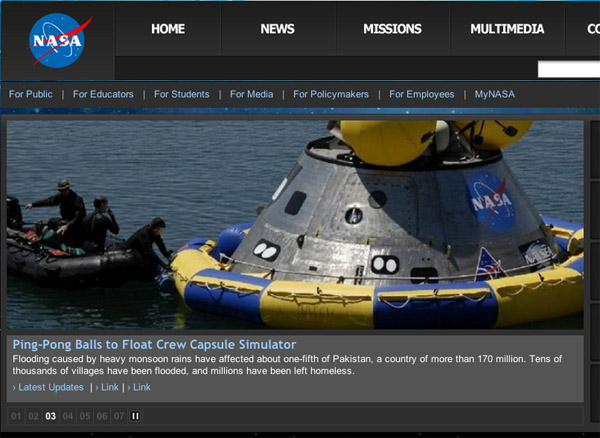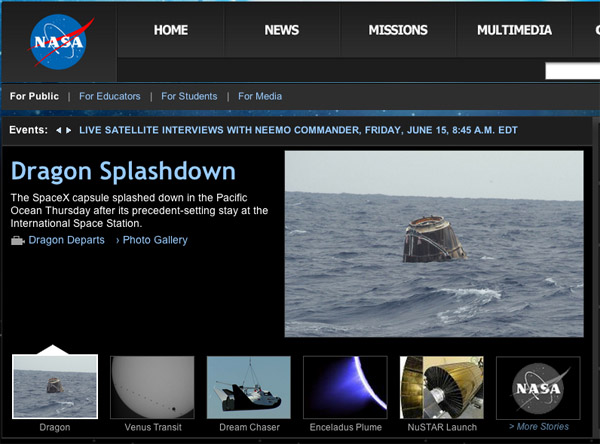Back in January we changed how we presented the main news stories on NASA’s Home Page. Under the old treatment


Back in January we changed how we presented the main news stories on NASA’s Home Page. Under the old treatment


With Thanksgiving behind us, we at NASA.gov are thankful for our colleagues across the country who work so hard to tell the story of NASA on the web. We’d like to take a few moments to point out some of the new enhancements we’ve all been working on this fall:


These are some of the larger items we’ve worked on this fall. Thanks to all of you who continue to give us feedback about the site. The tweets to @NASA, the e-mails to webcomments@hq.nasa.gov and the comments on our blog posts help us improve the site.
We’re thankful for all of you who have taken the time to come to NASA.gov and want you to keep coming back to catch up on the latest news and information about NASA.
NASA has recently received a lot of kudos for its social media efforts. We had 150 Tweeters, who in turn had about 150,000 followers, attend the Tweetup at the last space shuttle launch. NASA’s Twitter feed, now up to 417,000-plus followers, is one of the most influential on the service. The agency has embraced Facebook, YouTube and other social media services as well. (Though by now everyone should be aware that most of the channels tagged with “NASA” on those sites have nothing to do with the agency.) One of the things the nasa.gov Web team has been figuring out is how the social media efforts relate to the existing Web site, and how we get them to work together.
Fair warning: I’m about give rein to my inner numbers nerd.
The growth in NASA’s social media efforts hasn’t lessened the impact of the website. We’re up to 190,000 web pages on www.nasa.gov. Traffic grew by 18 percent from 2008 to 2009, outpacing the growth of the global online population (14 percent). Google says we’re the 604th most-popular site on the Web. Our customer-satisfaction ratings continue to be among the best on the Web, noticeably higher than most government agencies and not too far behind such popular sites as Google, Amazon and Netflix. And we were honored this year with our third People’s Voice Webby for best government site, for which we thank you.
Comparing metrics offers some insight to the relation between the website and social-media sites, with the weight of numbers tilting heavily toward the website. Compared to the Twitter followers, we had more than 8 million visits to the site in May, with an additional 12 million hits to our RSS feeds. Videos of the STS-132 launch were viewed more than 168,000 times from www.nasa.gov, and about half that many times on official NASA YouTube channels.
The benefit of social media, of course, isn’t the raw numbers of people coming to official sites; it’s in the sharing those people do with others. Non-NASA posts of private STS-132 launch videos were downloaded from YouTube another 50,000 times. (And if you haven’t seen it, check out the launch video shot out the window of a commercial airliner. Warning: contains profanity.) Similarly, at least according to one source, NASA is the 48th-most retweeted Twitter feed. NASA’s Facebook page has 59,000 fans, and though there’s no way to tell how many friends those fans have, it’s not unreasonable to think they could reach several million more.
So how do these tools work together? Social media is terrific for quickly releasing the constant parade of news that NASA has on any given day, from the minor to the extraordinary: Tweet it, share it on Facebook, post it to YouTube and Flickr. But limits on character counts and the types of content that can be posted to each site restrict one’s ability to supply background and context. They’re great at “Hey, this is cool”, but not as much in explaining why the cool thing is also important, or where it came from or where it might lead. That’s why that boring old Web 1.0 site — referred to by one of our bosses as the “brick-and-mortar website” — will always exist and continue to be important. That’s where the big picture is, where all the pieces of the puzzle — text, video images — can be pulled together in one place.
(As a government agency, we’re also concerned about what happens to the content on third-party sites if those sites disappear. Granted, in 2010 it’s hard to imagine YouTube going away. But in 1997 it was equally hard to imagine Netscape and AOL going away.)
At NASA we’re starting to try to merge the efforts. We’ve embedded our Twitter feed on the main page. Our new video player adopts some of the features of YouTube that have become de facto standards. The NASA web community is embracing third-party apps and sites sanctioned by the government. Integrating them all is going to have to become a fundamental part of any communications plan. Like everyone on the Net, we’ll learn as we go. If you’ve got suggestions, you’re welcome to post them here.
— Brian Dunbar